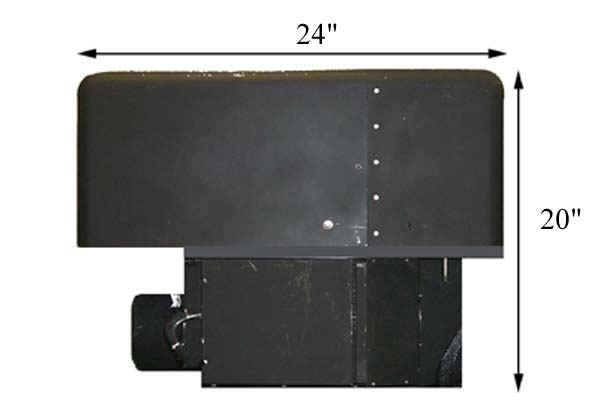Instrument
Instrument Description
The MASTER instrument was developed by the NASA Ames Research Center in conjunction with the Jet Propulsion Laboratory. The instrument consists of three key components: the scanning spectrometer, the digitizer and the storage system. The scanning unit was built by Sensys Technology (formerly Daedalus Enterprises,) and the digitizer was a collaborative effort between Berkeley Camera Engineering and the Ames Airborne Sensor Facility (ASF.) The data storage system and overall system integration were also provided by the ASF.
The MASTER instrument is similar to the MODIS Airborne Simulator (MAS) developed by the MODIS project (King et al. 1996). However, its has 2 key differences. First MASTER supports a variety of scan speeds allowing it to acquire contiguous imagery from a variety of altitudes with differing pixel sizes. Second the channel positions are configured to more closely match those of ASTER and MODIS.

The optical system is composed of a spectrometer mounted on a scanning fore-optic unit. Both the spectrometer and fore-optics portions are mated to an optical baseplate. The fore-optics consist of a full-face rotating scan mirror, canted 45° to the flight direction, directing light into an afocal Gregorian telescope with a 15.2 cm paraboloid main mirror. A folding mirror then directs the energy through a field stop aperture, and onto a 2.5-cm paraboloid Pfun assembly, which forms a colllimated beam with a 2.5 milliradian equivalent field of view. This is then directed by a deviating mirror into the spectrometer unit through a hole in the baseplate. The spectrometer is divided into four output sections or ports, each with its own detector array and associated optics. The input energy is wavelength-separated by a chain of dichroic beam splitters, and directed into each of the four output ports of the spectrometer (visible-near infrared (VNIR), shortwave infrared (SWIR), mid infrared (MIR) and thermal infrared (TIR)). A diffraction grating is mounted at each output port, which spectrally disperses the energy through a lens and onto a linear detector array. The bandpass of each individual channel is determined by the geometry of the detector array and its location with respect to the grating. Three of the four detector arrays (two InSb and one HgCdTe) are cryogenically cooled with liqued nitrogen; the silicon array for the VNIR channels is temperature-stabilized with a thermal-electric cooler. The HgCdTe array used with the TIR channels also has a cooled linear-variable filter mounted over it to reduce background noise (a similar installation will be made on the MIR array of MASTER shortly). This grating-based design maximizes optical efficiency, while remaining radiometrically flat to within one percent across the total field of view, and is not spectrally dependent on viewing angle.
The analog electrical signals from each detector are passed through a series of low-noise preamplifiers on the scan head, and are then passed to a digitizer via shielded twisted-pair cables. The first-stage preamplifiers on the Port 2 and 3 detector arrays (SWIR and MWIR) are cryogenically cooled within the dewar assemblies, to minimize noise. Specially designed adaptive, 16- bit analog-to-digital (A/D) converters are used in the digitizer, that actively track the DC level of the signal from the cooled detectors. This level, especially from HgCdTe arrays, typically drifts with time, and has been an historic source of calibration error in IR systems. The use of an actively adjusted, programmable preamplifier on the front end of the A/D converter allows this to be nullified, and the signal digitized very accurately, while preserving a full 16-bit dynamic range. Optical isolation was used, together with other noise reducing techniques, wherever possible in the system design. The digitized video signal is then merged with ancillary engineering and external navigation data, an is then stored on the hard disk. Further details of the optical system are given in King et al. (1996)
The MASTER channels are calibrated spectrally and radiometrically in the laboratory preflight and postflight. The mid-infrared and thermal infrared channels (26-50) are also radiometrically calibrated in-flight by viewing an internal hot and cold blackbody with each scanline. A 30” diameter integrating sphere is used as the primary radiometric source for calibrating the visible-shortwave infrared channels (1-25). The sphere is operated at four decreasing lamp levels, to establish linearity of the system response. The source itself is periodically calibrated against a NIST standard lamp, both by a team from the Goddard Space Flight Center and by the Ames Sensor Facility. Spectral characterizations are preformed with both a scanning monochrometer, and Fourier transform interferometer. This involves mounting the scanner over an 8” diameter collimator, interfaced to an optical bench for these measurements. The measured spectral response functions for some channels are atmospherically corrected with a radiative transfer model (MODTRAN), to remove the effects of water vapor and CO2 absorption. The MAS system also has viewed slit and knife-edge targets to establish spatial response; and has undergone polarization sensitivity characterization, which showed maximum response differences to be approximately 3%. Because this part of the MASTER system is identical to MAS it is currently assumed to have the same response, however, it will also be measured shortly. MASTER is also periodically characterized in a cold-chamber, to monitor radiometric and spectral stability at the operating temperature of the high altitude ER-2 aircraft.
